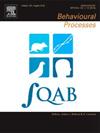Influence of wind on movement behaviour in Arctic grizzly bears
IF 1.3
4区 生物学
Q4 BEHAVIORAL SCIENCES
引用次数: 0
Abstract
Odours are emitted from organic matter and can contain important information about an animal’s surroundings, including the presence and location of other organisms. Wind acts as a conduit of olfactory information, affecting the spread and direction of odour dispersal across terrestrial landscapes. To increase the likelihood of detecting an odour molecule, individuals may exhibit anemotaxis – orientation bias to wind during movement – where the theoretical optimal olfactory search strategy is to move crosswind. We tested for biased movement relative to wind in Arctic grizzly bears (Ursus arctos) during the spring hypophagic period in the Mackenzie Delta, Northwest Territories, Canada using modelled winds and satellite-linked telemetry data (n = 12,430 locations) from 40 Arctic grizzly bears monitored between 2003 and 2010. Our results show that orientation relative to wind varied with movement rate, a proxy for active search effort. During steps where bears had high movement rates (> 90th percentile), bears predominantly oriented crosswind. We also found a positive relationship between movement rate and crosswind orientation: as bears moved faster, they increased their crosswind component of orientation. These results suggest an adaptive pattern of movement in response to wind, where bears oriented relative to the wind in a way that increased the likelihood of odour detection during active search. We suggest that future studies could include wind data in habitat selection and foraging models to examine its influence on habitat selection and use.
风对北极灰熊运动行为的影响。
气味是由有机物散发出来的,可以包含动物周围环境的重要信息,包括其他生物的存在和位置。风作为嗅觉信息的管道,影响着气味在陆地上的传播和方向。为了增加探测到气味分子的可能性,个体可能会表现出趋风性——在运动过程中对风的方向偏好——理论上最优的嗅觉搜索策略是移动侧风。在加拿大西北地区麦肯齐三角洲的春季食性期,我们使用模拟风和卫星连接的遥测数据(n = 12,430个地点)测试了北极灰熊(Ursus arctos)相对于风的偏向运动。这些数据来自2003年至2010年监测的40只北极灰熊。我们的结果表明,相对于风的方向随着移动速度而变化,这是主动搜索努力的一个代理。在熊有高移动率(bbb90百分位数)的步骤中,熊主要面向侧风。我们还发现移动速度和侧风方向之间存在正相关关系:当熊移动得更快时,它们的侧风方向成分也会增加。这些结果表明,熊对风的反应是一种适应性的运动模式,在这种模式下,熊相对于风的方向增加了在主动搜索过程中发现气味的可能性。我们建议未来的研究可以将风数据纳入栖息地选择和觅食模型,以研究其对栖息地选择和利用的影响。
本文章由计算机程序翻译,如有差异,请以英文原文为准。
求助全文
约1分钟内获得全文
求助全文
来源期刊

Behavioural Processes
生物-动物学
CiteScore
2.70
自引率
7.70%
发文量
144
审稿时长
4-8 weeks
期刊介绍:
Behavioural Processes is dedicated to the publication of high-quality original research on animal behaviour from any theoretical perspective. It welcomes contributions that consider animal behaviour from behavioural analytic, cognitive, ethological, ecological and evolutionary points of view. This list is not intended to be exhaustive, and papers that integrate theory and methodology across disciplines are particularly welcome.
 求助内容:
求助内容: 应助结果提醒方式:
应助结果提醒方式:


